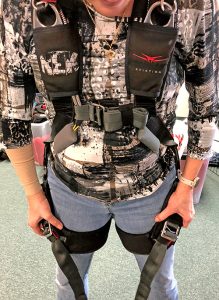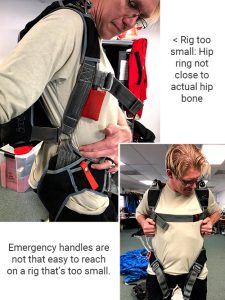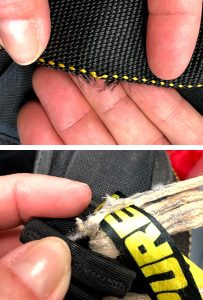<- If you missed it, check out Part 1: What gear should you get?
Now that we’ve decided on WHAT type and size of gear you want, it’s time for more details (since you’ve stuck around this long!). You can mix and match all four major rig components (main parachute, reserve, container, and automatic activation device) as new custom, new stock, or used equipment. Deciding what items you want new or used will give you a better idea of the total cost you’re looking at as well as a rough timeline of when you might be able to get it.
New Custom vs. New Stock Gear
All equipment bought new will give you options for the most modern technologies you will find on the market.
Pros of New Custom Gear: You specify all the options–size, harness measurements, colors/patterns, and options. It’s built to your exact specifications– it’s undoubtedly your creation and should fit you the best!
Cons:
- Obviously custom gear will generally be the most expensive option.
- Most manufacturers’ custom gear wait times can be pretty long, from many weeks or months to even longer than a year (yes, really).
- Depending on your personal progression in the sport, buying new gear and waiting a year for it to arrive can place you in a totally different point. For example, maybe you ordered a container that you now consider too big or too small.
- Progressing as a newer jumper on new gear can be intimidating because you may be worried about damaging your shiny new expensive equipment.
Pros of New Stock Gear: It is readily available from some manufacturers who keep commonly ordered sizes/types of new gear in stock (not all do). If you happen to want one of these common items and the manufacturer has it in stock in colors you like or at least can tolerate, with the options you want, then yay for you–you can get brand new gear fast!
Cons:
- New stock gear is likely to be second only to new custom gear in price.
- The harness may fit you well but not quite as well as fully custom gear (more information on fitting in a moment).
- The colors and options may not be your first choice.
- Same potential worries about damaging your shiny new expensive equipment as with custom gear.
Used Gear
Pros: Used gear can be a much faster option to get than new custom gear and similar in time frame to new stock gear–it already exists (unlike custom gear), you just have to get it to you. It’s also often much less expensive than new gear depending on its age, condition, features, and how much use it has seen. There is a wide range of used gear quality, from rigs or components with only a few skydives on them (nearly brand new) to equipment that is years or even decades old.
You can find plenty of used gear options online (such as on Facebook) or even better, in-person at your local DZ where you can try it on and have your local rigger check it out first. Used equipment is more forgiving of your wallet as well and loses less value with wear and tear over the course of you owning it, similar to the lower price and depreciation of buying a used car vs. new.
Cons:
- Used gear wasn’t designed specifically for you, but there is often used gear out there that was measured for people close to your size.
- It also may not be the colors you absolutely want, but maybe you can get by with them.
- Depending on the type of gear you are looking at, some may not be completely up to date with all the modern technology as well.
- Age plus its use/features may mean it has less usable life than a newer rig, and possibly less or little resale value when you are done with it.
- You’ll need to decide if you are only interested in complete used rigs, which may or may not have all the parts you would prefer, or if you are willing to research individual pieces of gear according to your specifications to assemble your own rig.
For the most part, the most daunting aspect of used gear is the research, which comes in three parts. Hopefully by this point in the article, you know the answer to part 1 which is: What do you want? In other words, which used gear listings fit that bill? Part 2, then, is…
How do I know if that gear will actually fit me?
Regardless of your progression or preferred discipline, a well-fitted container is going to benefit you in the long run. If the container doesn’t fit right, this can affect things like our comfort, ease of reaching handles at pull-time, canopy flight, and overall safety. The good news is that the only thing you actually need to fit is the container. You’ve already figured out what canopy sizes you need, and AAD don’t come in different sizes.
Used container sizes are often described in their listings something like this: “Fits 5 foot 8 inch tall human of average body size.”
Let’s be really clear:
THAT IS NOT ENOUGH INFORMATION TO SEE IF THIS WILL ACTUALLY FIT YOU.
People come in all shapes and sizes, and that includes different torso lengths and shoulder widths even on the same height of humans. The same rig may fit people of very different heights if they have a similar torso size, since your rig does not care how long your legs are. Alternatively, people of similar heights definitely can’t all fit well into the same size rig because of differences in shoulder width and body weight.

What you need, then, is to first get measured for a container by someone who knows what they are doing, such as your local pro shop manager. Get a copy of these measurements. Most containers from any manufacturer will require similar measurements, but some important details of measurements can be found around where your 3-ring system sits on your shoulders, the length of your main lift web, and the length of your laterals. The good news is whether you decide to buy a new container or search for the perfect-fitting used container, your local pro shop manager can professionally measure you. (For any professional service, a tip is more than appreciated.)
Armed with these measurements, you’re ready to see if gear will actually fit you. If the container you are considering has a standard set of harness sizes, find out what that harness size is and what yours should be based on your measurements. For example, Javelins have a letter followed by a number, such as C-16. The C denotes the yoke width over your shoulders (A is smaller than B, which is smaller than C, etc.). The 16 refers to the main lift web length. The pro shop manager who measured you can tell you which harness size you need in a Javelin, so compare the two and now you know if that used Javelin would fit you!

If you are looking at other containers, you may need to get the serial number of any container you are considering and contact the manufacturer with that serial number as well as your measurements, and ask them if that rig will fit you.
All of that said: Some details will still vary, such as length of the leg pads and laterals. Again, contacting the manufacturer with the serial number can help you find out those details. Also, some harness adjustments can be made by a master rigger or the manufacturer, or the rig can even be fully reharnessed if need be. Obviously neither option is free, and pricing will vary.
Now we’re on to part 3 of researching used gear…
HOW DO I KNOW IF THAT USED GEAR IS IN GOOD SHAPE?
If it’s the right size/type of gear and looks like it will fit, the last part is verifying it’s in as good a shape as the seller says it is. This means an inspection by a rigger you trust, and that’s not negotiable. Often a seller will note that the gear was inspected by so and so at such and such dropzone, and may even provide a copy of the report. That is great, but it is still a good idea to have your local rigger inspect the rig and verify.

DON’T PAY FOR THE RIG BEFORE INSPECTION!
Instead, ask to have the rig sent to your local dropzone for inspection by the rigger. Expect to pay for this part, and put the rig funds in escrow pending rig inspection results. No honest seller will have a major problem with you asking to put your payment in escrow, as it protects you both. Skydivers are generally honest with other skydivers, but there are crooks out there including those who are selling stolen gear or who acquired gear in abandoned storage unit sell-offs or via estates. Protect yourself!
Obviously there’s a lot to consider when buying this life-saving equipment! If you’ve read this far, you have a great start on getting gear that will work well for you for a long time. Happy skydiving!!!
By Brian Lane, Chief Instructor at Skydive Spaceland Dallas; and Christy West, Marketing Director at Skydive Spaceland
